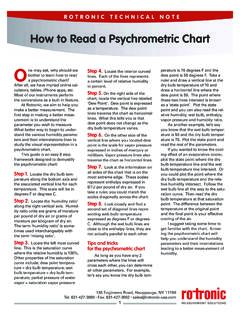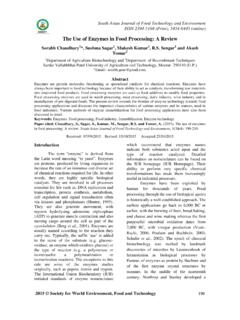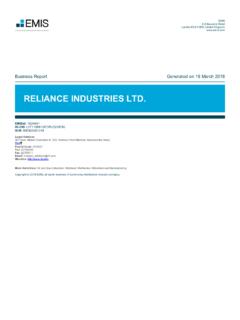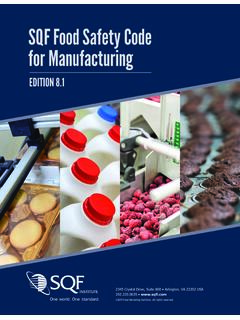Transcription of Beginner's guide to humidity measurement - ROTRONIC
1 Good Practice guide No. 124 The Beginner s guide to humidity MeasurementStephanie Bell measurement Good Practice guide No. 124 The Beginner s guide to humidity Stephanie Bell National Physical Laboratory Queen s Printer and Controller of HMSO, 2012. ISSN 1368-6550 September 2012 National Physical Laboratory Teddington, Middlesex, United Kingdom, TW11 OLW Extracts from this report may be reproduced provided the source is acknowledged and the extract is not taken out of context. NPL measurement Good Practice Guides This is one of a series of NPL guides about measurement . These guides are aimed at everyone who has an interest in measurement , whether in a laboratory, factory, hospital, university, college or in any other walk of life. The series includes beginner s guides, which introduce measurement concepts, methods and practices at a basic level.
2 More specialised guides cater for measurement professionals and practicing scientists and engineers who want to go more deeply into an area of measurement . References to additional guides or reading are given where appropriate. All these guides aim to promote good practice in measurement , and are produced with technical input from specialists in the particular subject covered. NPL is the UK s national measurement institute. It aims to deliver the highest economic and social benefits through world-leading and responsive science and knowledge services. This series of NPL Good Practice Guides provides one way to transfer knowledge to people who need to make better measurements. For more information or help with measurement problems visit Introduction to measurement measurement underpins science, technology and industry.
3 It enables processes to be run efficiently, and innovative and competitive products to be made. It impacts strongly on the welfare of a modern society and touches almost every aspect of daily life. A measurement tells us about a property of something. It might tell us how heavy an object is, or how hot, or how long it is. A measurement gives a number to that property, expressed in the appropriate unit. The units of measurement are standardised. The international System of Units (SI) is used worldwide so that measurements can be consistent everywhere. Measurements are only ever estimates. Every measurement is subject to some uncertainty. Perfect measurements cannot be made and so the true value is never known exactly. The uncertainty of a measurement expresses how good the estimate is thought to be.
4 A measurement result is incomplete without a statement of uncertainty. It is therefore in three parts: a number, a unit of measurement , and an uncertainty. For example, a length may be measured as cm + cm. The uncertainty of a measurement should suit the need: a school clock need not have atomic accuracy. Measuring equipment should be calibrated by comparison against a suitable reference which itself has been calibrated. An unbroken chain of calibrations linking back to a national standards body such as the National Physical Laboratory (NPL) is known as measurement traceability. Good measurement practice can reduce uncertainty and so improve the quality of processes and products. Contents NPL measurement Good Practice Guides .. 3 Introduction to measurement .. 4 0 About this guide .
5 1 1 Introduction .. 1 What is humidity ? .. 1 Why is humidity important? .. 1 2 Some humidity concepts .. 2 What qualities does water vapour have? .. 2 How do we quantify humidity ?.. 2 Other important humidity concepts .. 3 3 humidity -measuring instruments - hygrometers .. 4 Hygrometer types .. 4 Air temperature measurement .. 5 4 How to measure humidity .. 6 Selection of an instrument .. 6 Other points to consider .. 7 measurement set-up - sampling .. 7 Recording humidity measurement results .. 8 5 Some humidity measurement examples .. 9 6 Calibration and traceability of measurement .. 10 10 Uncertainty of measurement .. 11 7 humidity measurement : some do s and don ts .. 12 8 What can go wrong - troubleshooting .. 13 9 Special cases .. 14 10 humidity calculations and conversions .. 15 Tables.
6 15 humidity calculations .. 17 11 Further reading .. 18 12 Keywords and definitions for humidity .. 19 1 0 About this guide This is a guide to humidity measurement for beginners. It introduces the concept of humidity , and the basics of making a reliable humidity measurement . 1 Introduction What is humidity ? humidity is the presence of water vapour in air (or any other gas). In normal room air there is typically about 1 % water vapour, but it is widely present in greater or lesser amounts. High humidity makes hot days feel even hotter. Low humidity can give people a feeling of a dry throat, or sensations of static when touching things. humidity is measured using a hygrometer. Why is humidity important? humidity affects many properties of air, and of materials in contact with air.
7 Water vapour is key agent in both weather and climate, and it is an important atmospheric greenhouse gas. A huge variety of manufacturing , storage and testing process are humidity -critical. humidity measurements are used wherever there is a need to prevent condensation, corrosion, mould, warping or other spoilage of products. This is highly relevant for foods, pharmaceuticals, chemicals, fuels, wood, paper, and many other products. Air-conditioning systems in buildings often control humidity , and significant energy may go into cooling the air to remove water vapour. humidity measurements contribute both to achieving correct environmental conditions and to minimising the energy cost of this. Source: NPL One of nature s hygrometers: pine cones open at low humidity to release their spores. 2 2 Some humidity concepts Some main concepts are outlined below, and there is a list of keywords and definitions at the end of this guide .
8 What qualities does water vapour have? Water vapour is normally invisible, and behaves like a gas, except when it condenses to form water or ice. Even without condensing, water vapour can react with surfaces and penetrate materials. The capacity of a gas (or a space) to hold water vapour depends on its temperature: the higher the temperature, the more water vapour it can contain. How do we quantify humidity ? humidity is expressed in several different ways (see also the keywords at the end of this guide ). Relative humidity how saturated a gas (or a space) is with water vapour. This is the most commonly used measure of humidity . Usually expressed as a percentage, with the symbol %rh , for example The humidity is 51 %rh . The term relative humidity is commonly abbreviated to RH (note this is different from the unit symbol: %rh).
9 Interaction of water vapour with materials is often in proportion to relative humidity . Dew point (or dew-point temperature) - the temperature at which condensation (dew) would occur if a gas were cooled. Dew point is a useful measure for two reasons: The dew point tells us what temperature to keep a gas, to prevent condensation Dew point is an absolute measure of the gas humidity (at any temperature) and relates directly to the amount of water vapour present (partial pressure of water vapour). Dew point is expressed in temperature units, for example Today the dew point in my office is 10 C. If the condensation would be ice (below 0 C) then the term frost point is used. Fraction or ratio the proportion of water vapour in a gas.
10 This can be given in terms of mass, volume or amount of substance (moles). Concentration the amount or mass of water vapour per unit volume, for example room air might typically contain about 10 grams of water vapour per cubic metre. 3 Other important humidity concepts Saturation When a gas (or a space) holds the maximum water vapour possible at a given temperature, it is said to be saturated. If extra water is added to a saturated gas, or if its temperature is reduced, some of the water vapour will condense. Partial pressure A gas mixture such as air is made up of several pure gas components (such as oxygen, nitrogen and others). The total pressure of the gas is said to be the sum of partial pressures of the component gases. In room air, the partial pressure of water vapour might be around 1000 pascals (Pa).




